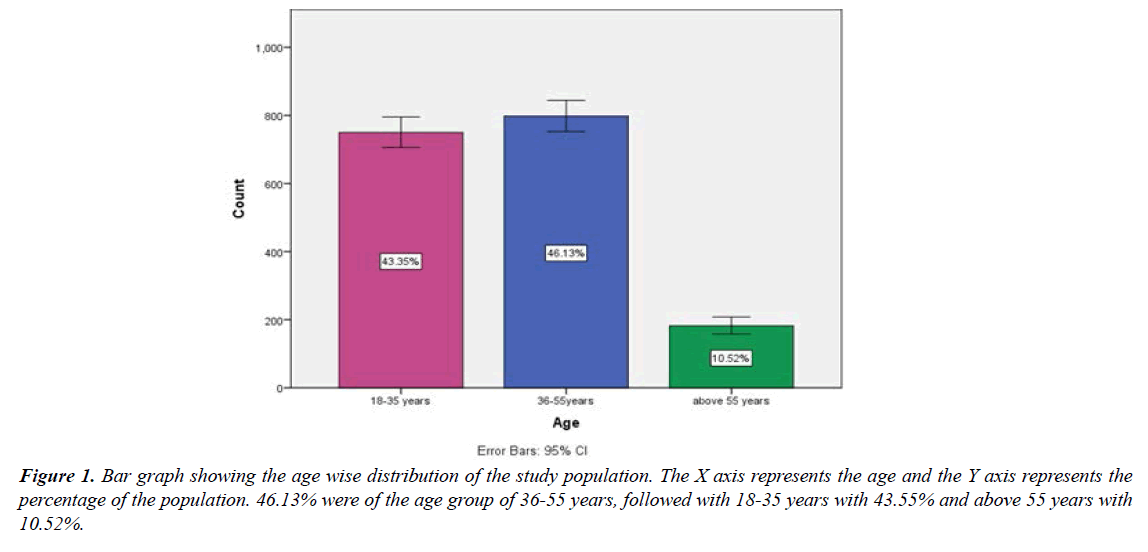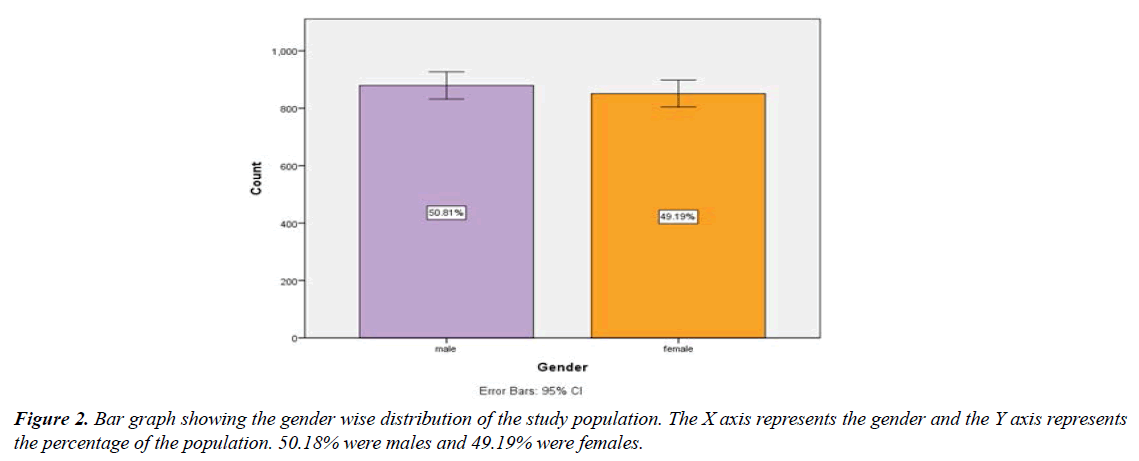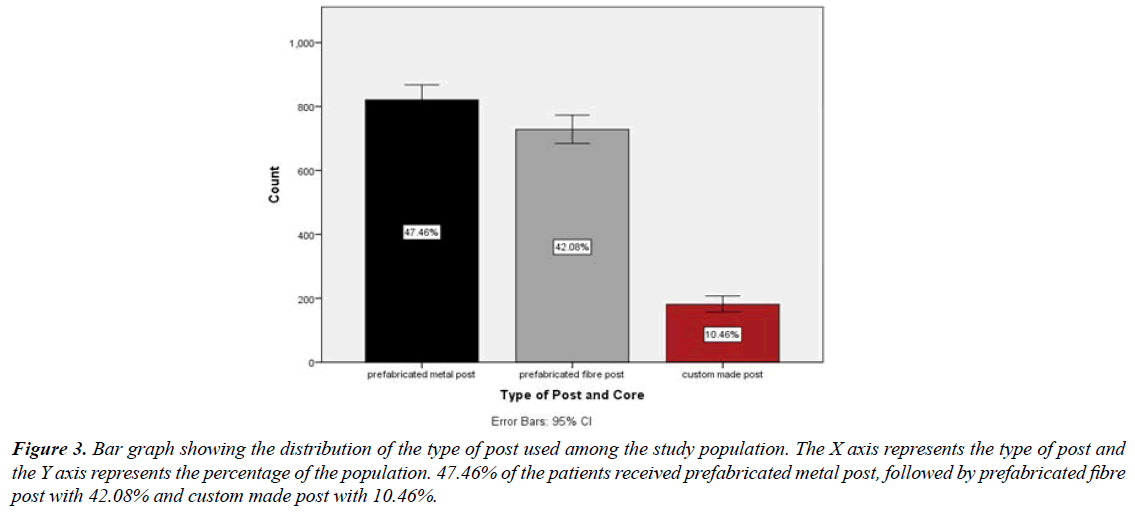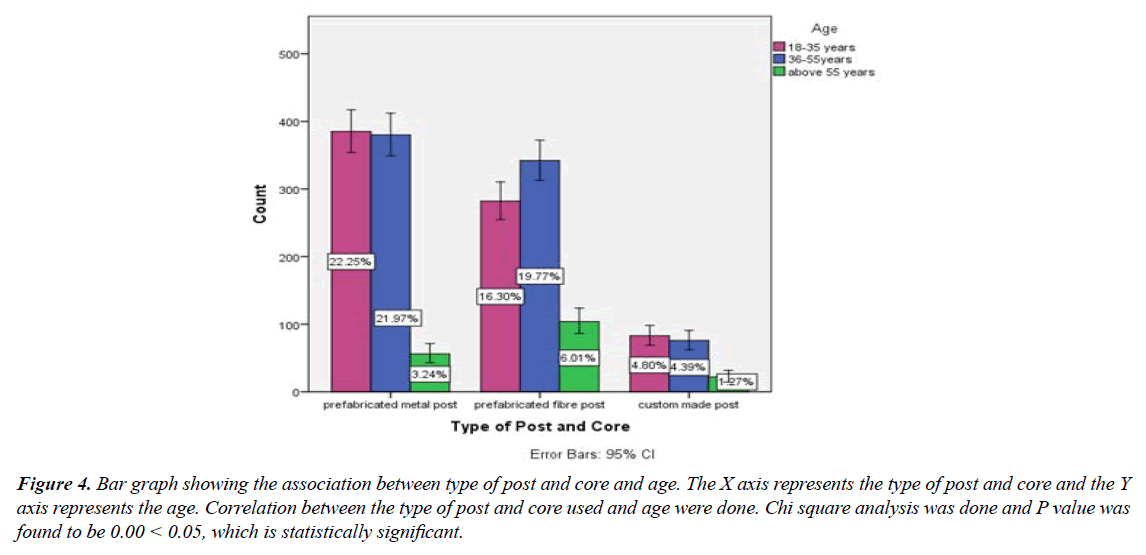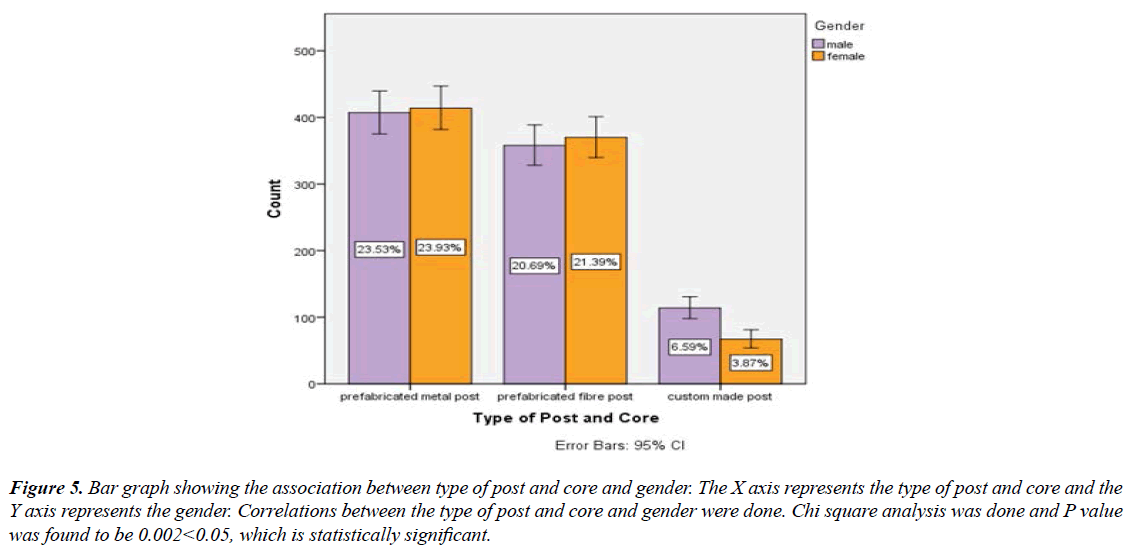Research Article - Journal of Clinical Dentistry and Oral Health (2022) Volume 6, Issue 6
Percentage of patients receiving prefabricated metal post and core as post endodontic restoration - A retrospective study
Shivani N, Mahalakshmi J*Department of Conservative dentistry and endodontics, Saveetha Dental College and Hospitals, Saveetha Institute of Medical and Technical Sciences, Saveetha University, Chennai, India
- *Corresponding Author:
- Mahalakshmi J
Department of Conservative dentistry and endodontics
Saveetha Dental College and Hospitals
Saveetha Institute of Medical and Technical Sciences
Saveetha University, Chennai, India
E-mail: mahalakshmij.sdc@saveetha.com
Received: 01-November-2022, Manuscript No. AACDOH-22-80358; Editor assigned: 03-November-2022, PreQC No. AACDOH-22-80358 (PQ); Reviewed: 17-November-2022, QC No. AACDOH-22-80358 (QC); Revised: 21-November-2022, Manuscript No. AACDOH-22-80358 (R); Published: 28-November-2022, DOI: 10.35841/aacdoh-6.6.130
Citation: Shivani N, Mahalakshmi J. Percentage of patients receiving prefabricated metal post and core as post endodontic restoration: A retrospective study. J Clinic Dent Oral Health. 2022;6(6):130
Abstract
Background: Endodontically treated Teeth often require post and core restoration for retention purposes because of extensive structural defects resulting from caries and Access cavity preparation there are various types of post and core materials used and each of them possess unique properties. Through this study we aim to evaluate the percentage of patients receiving prefabricated metal post as the post endodontic restoration. Methods and Materials: The total sample size of the study was 1730 patients. This was a comparative, descriptive study, where all the data of the patients who reported to the dental clinics in Saveetha dental College, Chennai, India was obtained from the Dental Information Archiving Software (DIAS). Patient record was collected between March 2020 and March 2021. Data was collected and tabulated. The collected data was further analysed, recorded in Microsoft Excel software and was subjected to statistical analysis using IBM SPSS statistics analyzer v.23.0.Chi square test was done with statistical significance p<0.05. Results: Out of the 1730 patients, 46.1% of the patients belonged to the 36-55 years age group. Among male and female, an almost equal predominance was found between the two in receiving post and core as a post endodontic restoration and among the various types of post and cores, 47.5% of the patients received prefabricated metal post. The association of the type of post and core with age and gender respectively, was found to be statistically significant P<0.005. Conclusion: From the study, it was found that the percentage of patients receiving prefabricated metal post was higher than those receiving prefabricated fibre post and custom-made post.
Keywords
Post and core, Ferrule, Fibre post, Metal post.
Introduction
Restoration of an endodontically treated tooth is extremely important as it impacts the long term prognosis of the tooth [1]. Root canal treated teeth are often associated with loss of coronal and radicular tooth structure from the preexisting restoration, caries or access preparation [2]. The primary purpose of a post is to retain a core in a tooth with extensive loss of coronal tooth structure. The post retains a core and the core retains a tooth [3]. Generally, a post space is to be created in the root canal in order to hold the post. However, the post space shouldn’t be enlarged as there will be too much loss of radicular Dentin which weakens the tooth and hence increases the chance of fracture [4].The post space is created by removing Gutta Percha from the root canal either using heat or chemical aid. It is best to remove Gutta Percha with rotary instruments. It is recommended that 4 to 5mm of GP remain in the apex to provide adequate seal and to have a post of length equal to 3/4th of the root canal [5]. The factors which are responsible for the resistance and retention of the post include the length, diameter and taper of the post, the luting cements and whether the post used is active or passive. The different kinds of post available or active and passive post, parallel and tapered post, prefabricated and custom-made post, ceramic and zirconia post [6]. Comparing the different types of posts available, metal post and core seemed to be standard in endodontics. Lately newer Materials have been introduced in the cast post system like fibre post, ceramic post, zirconia post etc. [7]. Our team has extensive knowledge and research experience that has translate into high quality publications [8-17]. The aim of the study is to evaluate the percentage of patients receiving prefabricated metal post as their post endodontic restoration [18-27].
In 1985, Hosubuchi, et al. reported that high cervical spinal cord stimulation (HC-SCS) induced significant cortical CBF increases, whereas thoracic level SCS did not show any CBF improvement [14]. Isono, et al. described improved CBF secondary to high cervical low frequency stimulation in large animal models, hypothesizing a role of specific spinal cord pathways which may contribute to increase CBF [13]. Patel et al. demonstrated that changes in CBF level varies with different spinal cord stimulation settings and that central processes are influenced by stimulation rather than modifying cervical sympathetic outflow [15]. Despite these studies, SCS for MCS patients’ needs more clarification, such as better patient selection criteria, improved neurophysiologic characterizations to adequately scale and continuously measure progress post-implant. This study is designed to provide more concrete details on High Cervical Stimulation therapy and future directions ‘The role of HC-SCS in restoring consciousness and overall clinical improvement in patients with MCS’.
Materials and Methods
This research study was defined as a descriptive study where all the patient’s data who reported to saveetha dental college and hospitals, SIMATS, Chennai, India and were diagnosed with pulpitis were obtained from the Dental Information Archiving Software (DIAS).
This study setting was a university setting and the research study was conducted in the dental clinics of Saveetha Dental College. This setting came with various pros and cons. The pros included the presence of a larger population and an abundant availability of data. Some of the cons included the study taking place in a unicentric setting and possessing a very limited demographic. This population was selected from the patients over the age of 18-67 years who visited the undergraduate and postgraduate dental clinics in Saveetha Dental College. The approval to undertake this research study had been approved by the Ethical Board of Saveetha University (applied). n = 1730 cases were reviewed and cross verification was performed by an additional reviewer. The minimization of sample bias was performed by an additional reviewer, acquiring all the data from within the university and as an additional measure, simple random sampling was performed. There was a presence of high internal and low external validity. Sample collection was performed from March 2020 to March 2021.
The data was then arranged in a methodical manner using Microsoft Excel software and was tabulated on the basis of 3 parameters namely, age of subject, gender of subject and type of post used as post endodontic restoration. The data was validated by an additional reviewer. Any incomplete or censored data that was present in the collected data was excluded from the study.
Results
The final dataset consisted of n=1730 patients of Indian origin who underwent post endodontic treatment. Among the 1730 participants, 46.13% patients belonged to 36-55 years age groups followed by 18-35 years with 43.55% and above 55 years with 10.52%. 50.81% of the participants were males and 49.19% were females. Among the various post and core systems available, 47.46% received prefabricated metal post, followed by prefabricated fibre post with 42.08% and custom made post with 10.46%.
Discussion
The data for this retrospective study was based on residents of Chennai seeking treatment at private dental College and Hospital in Chennai. Currently there are no studies showing the prevalence percentage of patients who received prefabricated metal post endodontic restoration.
From the current study it was found that most of about 46.13% of the participants belonged to the 36-55 years age group which was closely followed by the 18-35 years age group with 43.55% (Figure 1). And an equal number of male and female participants who received post and core as a post endodontic restoration (Figure 2).
About 47.46% of the participants received prefabricated metal post and 42.1% received prefabricated fibre post while 10.5% of the participants received custom made cast post (Figures 3 to Figure 5). In a study done by Choudhary S et al, it is observed that cast metal post and core systems have better retention when compared to other post systems [28].
Figure 3: Bar graph showing the distribution of the type of post used among the study population. The X axis represents the type of post and the Y axis represents the percentage of the population. 47.46% of the patients received prefabricated metal post, followed by prefabricated fibre post with 42.08% and custom made post with 10.46%.
Figure 4: Bar graph showing the association between type of post and core and age. The X axis represents the type of post and core and the Y axis represents the age. Correlation between the type of post and core used and age were done. Chi square analysis was done and P value was found to be 0.00 < 0.05, which is statistically significant.
Figure 5: Bar graph showing the association between type of post and core and gender. The X axis represents the type of post and core and the Y axis represents the gender. Correlations between the type of post and core and gender were done. Chi square analysis was done and P value was found to be 0.002<0.05, which is statistically significant.
From a study it was found that fibre posts had as high as 100% success rate in terms of root fracture [29]. Another study found that the failure rate of fibre post in terms of root fracture was as low as 1.7% [30] to as high as 13% [31]. The reason for this could be due to the near dentin modulus of elasticity of the fibre post which gives it increased resistance to root fractures [32].
Metal posts or known to be standard posts that are used in dentistry. These are in use from a very long time and or the conventional post. These posts have their disadvantages such as root fracture, micro leakage, metal corrosion etc. The metallic corrosion product weakens the dentin and the interface between the post and the prepared canal hence resulting in fracture. Fibre post is ready to use, saves time and can be easily retrieved from the canal. They aren’t retrieved in one piece like a cast or prefabricated post; best are removed from the Canal by drilling down directly through them. Although fibre posts or newer, reliable and easy to retrieve, metal posts are used in large numbers as they are the standard in endodontics.
Conclusion
From the current study, it was noted that among the various kinds of post and core systems available, prefabricated metal posts were most commonly employed as a post endodontic restoration.
Acknowledgements
The authors sincerely acknowledge the faculty Medical record department and Information technology department of SIMATS for their tireless help in sorting out data’s pertinent to this study.
Funding
The present project is supported/funded/sponsored by Saveetha Institute of Medical and Technical Sciences, Saveetha Dental College and Hospitals, Saveetha University contributed by Metro Metal Trading Corporation.
Conflict of interest
Authors declare no potential conflicts of interest.
References
- Mehta SB, Millar BJ. A comparison of the survival of fibre posts cemented with two different composite resin systems. Br Dent J. 2008;205(11):e23.
- Cohen BI, Pagnillo M, Musikant BL, et al. Comparison of the retentive and photoelastic properties of two prefabricated endodontic post systems. J Oral Rehabil. 1999;26(6):488-94.
- Dilmener FT, Sipahi C, Dalkiz M. Resistance of three new esthetic post-and-core systems to compressive loading. J Prosthet Dent. 2006;95(2):130-6.
- Al-Wahadni AM, Hamdan S, Al-Omiri M, et al. Fracture resistance of teeth restored with different post systems: in vitro study. Oral Surg Oral Med Oral Pathol Oral Radiol Endodont. 2008;106(2):e77-83.
- Aydemir H, Ceylan G, Tasdemir T, et al. Effect of immediate and delayed post space preparation on the apical seal of root canals obturated with different sealers and techniques. JAOS. 2009;17:605-10.
- Fernandes AS, Dessai GS. Factors affecting the fracture resistance of post-core reconstructed teeth: a review. Int J Prosthodont 2001;14:355–63.
- Morgano SM, Milot P. Clinical success of cast metal posts and cores. J Prosthet Dent. 1993;70(1):11-6.
- Muthukrishnan L. Imminent antimicrobial bioink deploying cellulose, alginate, EPS and synthetic polymers for 3D bioprinting of tissue constructs. Carbohydr Polym.2021;260:117774.
- PradeepKumar AR, Shemesh H, Nivedhitha MS, et al. Diagnosis of vertical root fractures by cone-beam computed tomography in root-filled teeth with confirmation by direct visualization: A systematic review and meta-analysis. J Endod. 2021;47(8):1198-214.
- Chakraborty T, Jamal RF, Battineni G, et al. A Review of Prolonged Post-COVID-19 Symptoms and Their Implications on Dental Management. IJERPH. 2021;18(10):5131.
- Muthukrishnan L. Nanotechnology for cleaner leather production: a review. Environ Chem Lett. 2021 ;19(3):2527-49.
- Teja KV, Ramesh S. Is a filled lateral canal–A sign of superiorit?. J Dent Sci. 2020;15(4):562.
- Narendran K, MS N, SARVANAN A. Synthesis, characterization, free radical scavenging and cytotoxic activities of phenylvilangin, a substituted dimer of embelin. Indian J Pharm Sci. 2020;82(5):909-12.
- Reddy P, Krithikadatta J, Srinivasan V, et al. Dental caries profile and associated risk factors among adolescent school children in an urban South-Indian city. Oral Health Prev Dent. 2020;18(1):379-86.
- Sawant K, Pawar AM, Banga KS, et al. Dentinal microcracks after root canal instrumentation using instruments manufactured with different NiTi alloys and the SAF system: A systematic review. Appl Sci. 2021;11(11):4984.
- Bhavikatti SK, Karobari MI, Zainuddin SL, et al. Investigating the antioxidant and cytocompatibility of Mimusops elengi Linn extract over human gingival fibroblast cells. IJERPH. 2021;18(13):7162.
- Karobari MI, Basheer SN, Sayed FR, et al. An in vitro stereomicroscopic evaluation of bioactivity between Neo MTA Plus, Pro Root MTA, BIODENTINE & glass ionomer cement using dye penetration method. Mater. 2021;14(12):3159.
- Rohit Singh T, Ezhilarasan D. Ethanolic extract of Lagerstroemia speciosa (L.) Pers., induces apoptosis and cell cycle arrest in HepG2 cells. Nutr Cancer. 2020;72(1):146-56.
- Ezhilarasan D. MicroRNA interplay between hepatic stellate cell quiescence and activation. Eur J Pharmacol. 2020;885:173507.
- Romera A, Peredpaya S, Shparyk Y, et al V. Bevacizumab biosimilar BEVZ92 versus reference bevacizumab in combination with FOLFOX or FOLFIRI as first-line treatment for metastatic colorectal cancer: a multicentre, open-label, randomised controlled trial. Lancet Gastroenterol Hepatol. 2018;3(12):845-55.
- Raj R K. β‐Sitosterol‐assisted silver nanoparticles activates Nrf2 and triggers mitochondrial apoptosis via oxidative stress in human hepatocellular cancer cell line. J Biomed Mater. 2020;108(9):1899-908.
- Vijayashree Priyadharsini J. In silico validation of the non‐antibiotic drugs acetaminophen and ibuprofen as antibacterial agents against red complex pathogens. J Periodontol. 2019;90(12):1441-8.
- Priyadharsini JV, Girija AS, Paramasivam A. In silico analysis of virulence genes in an emerging dental pathogen A. baumannii and related species. Arch Oral Biol. 2018;94:93-8.
- Uma Maheswari TN, Nivedhitha MS, Ramani P. Expression profile of salivary micro RNA-21 and 31 in oral potentially malignant disorders. Braz Oral Res. 2020;34.
- Gudipaneni RK, Alam MK, Patil SR, et al. Measurement of the maximum occlusal bite force and its relation to the caries spectrum of first permanent molars in early permanent dentition. Int J Clin Pediatr Dent. 2020;44(6):423-8.
- Chaturvedula BB, Muthukrishnan A, Bhuvaraghan A, et al. Dens invaginatus: A review and orthodontic implications. Br Dent J. 2021;230(6):345-50.
- Kanniah P, Radhamani J, Chelliah P, et al. Green synthesis of multifaceted silver nanoparticles using the flower extract of Aerva lanata and evaluation of its biological and environmental applications. ChemistrySelect. 2020;5(7):2322-31.
- Choudhary S, Begum Z, Choudhary P, et al. Comparative evaluation of retention of prefabricated and conventional cast post: An in vitro study. JISPCD. 2014;4(2):87.
- Naumann M, Sterzenbach G, Franke A, et al. Randomized controlled clinical pilot trial of titanium vs glass fiber prefabricated posts: Preliminary results after up to 3 years. IJP. 2007;20(5):499.
- Malferrari S, Monaco C, Scotti R. Clinical Evaluation of Teeth Restored with Quartz Fiber--Reinforced Epoxy Resin Posts. IJP. 2003;16(1).
- Mannocci F, Bertelli E, Sherriff M, et al. Three-year clinical comparison of survival of endodontically treated teeth restored with either full cast coverage or with direct composite restoration. J Prosthet Dent. 2002;88(3):297-301.
- Meira JB, Espósito CO, Quitero MF, et al. Elastic modulus of posts and the risk of root fracture. Dent Traumatol. 2009;25(4):394-8.
Indexed at, Google Scholar, Cross Ref
Indexed at, Google Scholar, Cross Ref
Indexed at, Google Scholar, Cross Ref
Indexed at, Google Scholar, Cross Ref
Indexed at, Google Scholar, Cross Ref
Indexed at, Google Scholar, Cross Ref
Indexed at, Google Scholar, Cross Ref
Indexed at, Google Scholar, Cross Ref
Indexed at, Google Scholar, Cross Ref
Indexed at, Google Scholar, Cross Ref
Indexed at, Google Scholar, Cross Ref
Indexed at, Google Scholar, Cross Ref
Indexed at, Google Scholar, Cross Ref
Indexed at, Google Scholar, Cross Ref
Indexed at, Google Scholar, Cross Ref
Indexed at, Google Scholar, Cross Ref
Indexed at, Google Scholar, Cross Ref
Indexed at, Google Scholar, Cross Ref
Indexed at, Google Scholar, Cross Ref
Indexed at, Google Scholar, Cross Ref
Indexed at, Google Scholar, Cross Ref
Indexed at, Google Scholar, Cross Ref
Indexed at, Google Scholar, Cross Ref
Indexed at, Google Scholar, Cross Ref
Indexed at, Google Scholar, Cross Ref
Indexed at, Google Scholar, Cross Ref
Indexed at, Google Scholar, Cross Ref
